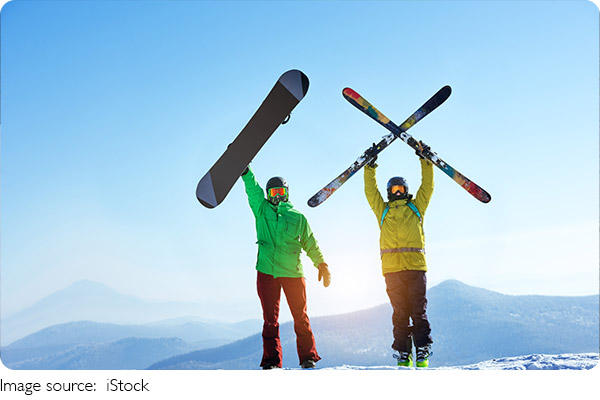Extreme Sports Culture

Have you ever seen someone fly off a snowy cliff on skis or flip a board down a stair rail in the city? These jaw-dropping moments are part of a fast-growing global trend—extreme skiing and skateboarding.
More than just sports, they've become a lifestyle, a culture, and a movement for youth around the world. Let's take a closer look at why these sports are exploding in popularity and how they've become symbols of modern cool.
What Is Extreme Skiing?
Extreme skiing is all about going beyond the typical ski resort experience. It involves steep slopes, natural terrain, cliffs, trees, and often untouched powder. Skiers use advanced gear and years of practice to navigate dangerous and exciting runs.
Also called "freeride" or "big mountain skiing," this version of the sport became popular in the late 1990s. Now, it has its own competitions like the Freeride World Tour, which features the best skiers tackling wild terrain in countries like Switzerland, Canada, and Japan.
What Makes Skateboarding Stand Out?
Skateboarding, on the other hand, started in the streets. Unlike skiing, which needs snow and mountains, all you need for skateboarding is a board and concrete. Skaters create tricks and style by using urban obstacles—rails, steps, and ramps—as their playground.
Skateboarding became a part of the Olympic Games in 2021, bringing it more into the mainstream. But even before that, it had a deep connection to music, fashion, and youth identity. It's more than a sport—it's self-expression with wheels.
The Culture Behind the Sports
What makes both sports exciting is the culture behind them. Extreme skiing and skateboarding celebrate creativity, courage, and pushing limits. They attract people who aren't just looking to compete—but who want to create something new, face challenges, and explore new places.
Videos, streetwear, and social media have all played big roles. Brands like Red Bull and GoPro sponsor athletes and events that reach millions of viewers online. Skaters and skiers post their own tricks and edits on YouTube and Instagram, growing their followings without needing traditional media.
Global Influence and Diversity
These sports are no longer limited to certain countries. Thanks to the internet, people in places like Brazil, South Korea, and South Africa are picking up boards or skis and joining the movement.
In Japan, deep powder and tree skiing have become famous. In Brazil, skaters cruise through the streets of São Paulo and Rio. In Korea, the popularity of skateboarding has surged after its Olympic debut. Public skate parks and ski resorts are being built more than ever.
This globalization has brought more diversity to these sports—different styles, new perspectives, and fresh energy.
Technology Is Changing the Game
Technology has helped these sports grow in exciting ways. Skis are lighter and more responsive, letting riders perform more advanced moves. Drones and action cameras allow for incredible video footage, which fuels online communities and inspires others to try.
Apps like Strava or Trace allow skiers to track their performance, and editing tools make it easy for skaters to share their tricks with the world. The combination of tech and sport creates new levels of connection and motivation.
Health, Fitness, and Mental Benefits
While extreme sports look risky, they also come with serious physical and mental benefits. Studies published in Frontiers in Psychology have shown that participants in action sports develop greater resilience, concentration, and self-confidence.
Dr. Rachael Martin, a sports psychologist, points out: "Sports like skateboarding and extreme skiing promote flow states. These are moments where the athlete is fully focused and in control. It's good for mental balance and personal growth."
Physically, these sports demand coordination, agility, balance, and strength. They also build core muscles and cardiovascular endurance.
Challenges and Safety
With thrill comes risk. Falls, injuries, and environmental dangers are real concerns. That's why experienced athletes take training and safety seriously. Helmets, pads, and smart planning are now part of everyday riding.
In the skiing world, avalanche awareness is critical. Many skiers take certified avalanche courses before venturing into backcountry zones. Similarly, cities are creating safer skate parks to reduce street injuries while still supporting skate culture.
How Youth Are Leading the Charge
Teens and young adults are at the heart of this trend. Schools, local clubs, and youth programs are helping more young people get involved. In some countries, skateboarding is part of physical education. In others, ski camps are teaching not just sport skills, but environmental awareness and teamwork.
The passion of the younger generation is shaping the future of these sports—bringing new ideas, greater inclusivity, and more global connection.
The Future: Olympics, Inclusion, and More
With events like the Winter Olympics adding freestyle skiing, and summer games continuing to feature skateboarding, these sports are now recognized on the world stage. There's talk of adding more disciplines, like ski mountaineering and street skateboarding, to future competitions.
More importantly, the focus is shifting toward inclusion and sustainability. Eco-friendly ski gear and community-built skate parks are becoming the norm. Programs are also growing that bring these sports to underserved communities.

Final Thoughts
Whether you love watching jaw-dropping tricks or dream of catching air yourself, extreme skiing and skateboarding are here to stay—and growing every day. These sports are not only thrilling but also deeply meaningful to millions of people worldwide.

 · Sport Team
· Sport Team